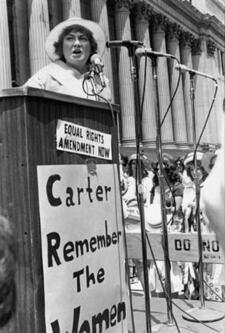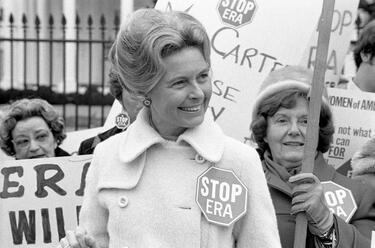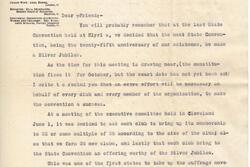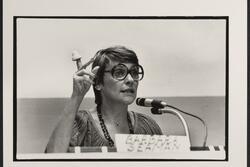Mrs. America: Who's Afraid of The ERA?
On January 27, the Virginia Senate voted to adopt the Equal Rights Amendment (ERA), becoming the 38th and final state needed to ratify the proposed Constitutional Amendment banning discrimination on the basis of sex. The Equal Rights Amendment has an unclear future—after it passed through Congress in 1972, the Amendment’s 1982 deadline lapsed before the necessary 38-state mark, and five states have already voted to “rescind” their ratifications. Before the climactic floor vote in Virginia, the Justice Department’s Office of Legal Counsel announced that it considered the ERA expired. But, as ERA expert Professor Julie C. Suk explains, the Constitution does not grant the Trump administration the authority to decide what happens to the ERA next. Other signs indicate that the ERA still stands a chance—for instance, the states did not ratify the text of the deadline, making the deadline possibly nonbinding.
In the midst of the arguments over the technical future of the ERA, feminists and their opponents alike wonder if we even need an Equal Rights Amendment. Legal scholars debate whether an ERA would transform the legal landscape and elevate the level of scrutiny with which the court approaches sex discrimination cases, or if its value would be merely symbolic. In a much-shared editorial in The New York Times, Professor Joan Williams rejected the new push for the Equal Rights Amendment as an elitist, misguided effort that will result in a “backlash” over contentious “cultural” issues like abortion and transgender access to public bathrooms. Williams argues that a renewed focus on the ERA will mobilize “family values” voters around contentious social issues that both proponents and opponents of the ERA think will be impacted by the amendment.
While I disagree with Williams’s assertion that there’s anything elitist or merely “cultural” about supporting abortion access and LGBTQ rights, she’s right that the ERA has become a new political flashpoint. Leaders at the recent March for Life rallied against the ERA on the grounds that it could be a potential legal tool for expanding abortion access (which is, ironically, the reason I support it). Conservative magazine The Federalist frantically announced that an ERA would lead to the draft of women, the abolishment of sororities and women’s sports, mandatory gender-neutral bathrooms, admission of men to domestic violence shelters, and “female-only nursing rooms opened to men.”

Bella Abzug speaking at a New York City Rally in 1976. The podium's stickers read "Equal Rights Amendment Now" and "Carter Remember the Women."
Copyright © Diana Mara Henry / dianamarahenry.com
It all raises the question: How could anyone find the ERA controversial? The proposed amendment simply states, “Equality of rights under the law shall not be denied or abridged by the United States or by any state on account of sex.” According to a 2001 survey, 72 percent of Americans already think the Constitution specifies that citizens have equal rights regardless of gender. Modern opponents of the ERA are copying and pasting—or, in the spirit of the era, mimeographing—the arguments of the 1970s, down to the same exact lines about women in the military, expanded abortion access, and mandatory gender neutral bathrooms. The anxieties of Phyllis Schlafly, anti-feminist campaigner and anti-ERA organizer, are as alive and well in 2020 as they were in 1977. To understand the modern so-called “culture wars,” we have to trace their roots back to Schlafly’s movement to portray the ERA as the downfall of femininity, motherhood, and civilization as we know it.
It’s particularly timely that as the heated debate over the Equal Rights Amendment has reentered the public consciousness, FX released the first trailer for the upcoming miniseries Mrs. America. The miniseries focuses on the feminist and anti-feminist movements of 1970s with an all-star cast: Cate Blanchett as Schlafly, Rose Byrne as journalist Gloria Steinem, Niecy Nash as lawyer and activist Flo Kennedy, Margo Martindale as Congresswoman Bella Abzug, Uzo Aduba as Congresswoman Shirley Chisholm, Elizabeth Banks as political staffer and activist Jill Ruckelshaus, Tracey Ullman as Betty Friedan, and Sarah Paulson as “Alice,” a fictional protagonist. The series will explore how these characters navigated the seismic legal and political changes of the time, focusing on milestones like the 1977 National Women’s Conference. Gloria Steinem has described the conference as “the most important event nobody knows about”-- a four-day event in Houston that attempted to determine a national political agenda by and for the women of the United States.
But the conference—and by extension, Mrs. America—dramatically revealed that finding a united political agenda for women was easier said than done. As Professor Majorie Spruill details in her 2017 book Divided We Stand, Schlafly’s STOP ERA campaign fiercely organized around the country to elect conservative women as state delegates to the conference. She successfully create a sizable contingent of anti-feminist voters that tried to defeat various progressive planks in the convention’s National Plan of Action. Within the convention hall, anti-ERA turned their backs on speakers arguing for abortion rights. Across the street, Schlafly held an almost entirely white and largely male conservative counter-rally under banners like “Women’s Libbers, E.R.A. LESBIANS, REPENT. Read the BIBLE while YOUR [sic] ABLE.”
To the modern viewer, there’s a sort of morbid fascination in watching Blanchett’s Schlafly argue against the freedoms that she enjoys. Schlafly rails against women working outside the home, even as Schlafly herself chafes when her husband tries to constrain her lobbying and speaking career. It’s tempting to sneer, or to laugh at the anti-feminist woman as a relic of the 70s. How could women organize against their own interests? But the lesson from Houston that I hope Mrs. America will explore is that women hold a wide range of political beliefs. Even among the feminist delegates, there were those like Betty Friedan who threatened to vote against a plank in support of lesbian rights out of fear it would sink the ERA. (Friedan eventually supported the plank after a hotel room meeting that culminated in a sobbing Friedan locking herself in the bathroom and screaming at everyone to get out.) More encouragingly, the Convention brought together feminist women of vastly different identities to share their stories, an experience many attendees described as deeply transformative.
In featuring the story of Schlafly—who was racist, misogynist, and homophobic, but undeniably politically savvy—Mrs. America will also demonstrate that feminists underestimate the power of anti-feminist women at their own peril. Spruill argues that the Conference sparked a Republican realignment on feminism that persists to this day. Until the conference, the Republican Party supported the ERA and legal abortion. Without Schlafly and her organized conservative women, it is hard to imagine the ERA getting bogged down in the states. As Professor Melissa Murray explains, we are still feeling the impact of the ERA’s failure through the resulting patchwork of anti-discrimination caselaw. This patchwork, according to Professor Kimberlé Crenshaw, does not accurately combat how discrimination functions in the real world, particularly against Black women. Even this inadequate state of affairs is increasingly fragile in the era of Gorsuch and Kavanaugh, to say nothing of the 187 conservative judges President Trump has appointed to the federal bench for life, who will have a far greater direct impact on the judicial system and the enforcement of antidiscrimination law than the Supreme Court.
Ultimately, we can learn the same lesson from 1977 that we should have learned in 2016. Strangely, I think it may be the only takeaway Phyllis Schlafly and I would agree on: “Woman” is not a synonym for “feminist.” Despite all the “future is female” and “elect women” rhetoric implying that simply elevating women’s influence will result in feminist change, more than half of white women voted for Donald Trump. During the Kavanaugh hearings, an image of a row of female onlookers grimacing over his shoulder went viral, only for it to come out that the women were Kavanaugh’s supporters. That Federalist article fretting about gender-neutral lactation rooms was written by a woman, Tabitha Walter— director of the Eagle Forum, a right-wing group founded by Phyllis Schlafly.
Mrs. America will show viewers that the women of the United States are not a political monolith. Going by the trailer, it seems the series will be loyal to the complexities of the feminist debates of in the 1970s. At one point, White House official Jill Ruckelshaus explains, “We do not want housewives thinking that we are against them.” A younger activist at her side shoots back, “We are against them!” Ultimately, I have high hopes that in the age of a new ERA, Mrs. America will depict women’s politics as nuanced, messy, painful, and even repulsive as they really are.









Good to read an honest and in-depth reaction to this superficial tv series. I knew Bella, her two daughters, have researched her biography. She was a brilliant lawyer who got legislation passed... and much much better looking than the person portraying her in Mrs. America.
I hope there will be a better biography of Bella made for television or Netflix. Please discuss with me!